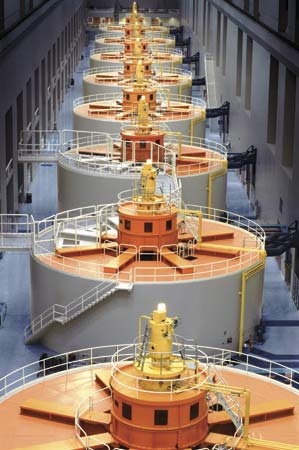hydroelectric power
 electricity produced from generators driven by water turbines that convert the potential energy in falling or fast-flowing water to mechanical energy.
electricity produced from generators driven by water turbines that convert the potential energy in falling or fast-flowing water to mechanical energy.In the generation of hydroelectric power, water is collected or stored at a higher elevation and led downward through large pipes or tunnels (penstocks) to a lower elevation; the difference in these two elevations is known as the head. At the end of its passage down the pipes, the falling water causes turbines (turbine) to rotate. The turbines in turn drive generators (electric generator), which convert the turbines' mechanical energy into electricity. Transformers (transformer) are then used to convert the alternating voltage suitable for the generators to a higher voltage suitable for long-distance transmission. The structure that houses the turbines and generators, and into which the pipes or penstocks feed, is called the powerhouse.
Hydroelectric power plants are usually located in dams (dam) that impound rivers, thereby raising the level of the water behind the dam and creating as high a head as is feasible. The potential power that can be derived from a volume of water is directly proportional to the working head, so that a high-head installation requires a smaller volume of water than a low-head installation to produce an equal amount of power. In some dams, the powerhouse is constructed on one flank of the dam, part of the dam being used as a spillway over which excess water is discharged in times of flood. Where the river flows in a narrow steep gorge, the powerhouse may be located within the dam itself.
In most communities, electric-power demand varies considerably at different times of the day. To even the load on the generators, pumped-storage hydroelectric stations are occasionally built. During off-peak periods, some of the extra power available is supplied to the generator operating as a motor, driving the turbine to pump water into an elevated reservoir. Then, during periods of peak demand, the water is allowed to flow down again through the turbine to generate electrical energy. Pumped-storage systems are efficient and provide an economical way to meet peak loads.
In certain coastal areas, such as the Rance River estuary in Brittany, France, hydroelectric power plants have been constructed to take advantage of the rise and fall of tides (tidal power). When the tide comes in, water is impounded in one or more reservoirs. At low tide, the water in these reservoirs is released to drive hydraulic turbines and their coupled electric generators (see tidal power).
Falling water is one of the three principal sources of energy used to generate electric power, the other two being fossil fuels and nuclear fuels. Hydroelectric power has certain advantages over these other sources: it is continually renewable owing to the recurring nature of the hydrologic cycle and produces neither atmospheric nor thermal pollution. Hydroelectric power is a preferred energy source in areas with heavy rainfall and with hilly or mountainous regions that are in reasonably close proximity to the main load centres. Some large hydro sites that are remote from load centres may be sufficiently attractive to justify the long high-voltage transmission lines. Small local hydro sites may also be economical, particularly if they combine storage of water during light loads with electricity production during peaks.
- Karl, Freiherr (baron) von Vogelsang
- Karl, Freiherr Mack von Leiberich
- Karl, Freiherr von Rokitansky
- Karl Friedrich Goerdeler
- Karl Friedrich Mohr
- Karl Friedrich Philipp von Martius
- Karl Friedrich Schinkel
- Karl Gegenbaur
- Karl Georg Christian von Staudt
- Karl Goldmark
- Karl Gotthard Lamprecht
- Karl Gustav, Greve Wrangel
- Karl Gustav Wrangel, Greve
- Karl Gutzkow
- Karl Haushofer
- Karl Heinrich Ferdinand Rosenbusch
- Karlheinz Stockhausen
- Karl Hermann Frank
- Karl Hjalmar Branting
- Karl Humann
- Karli
- Karl Jansky
- Karl Jaspers
- Karl Joseph Simrock
- Karl Karlovich Klaus